Key Takeaways
- Enhance customer satisfaction and loyalty by implementing seven proven strategies to improve your customer service levels and create delightful experiences.
- Set clear goals, hire and train customer-focused staff, implement effective communication channels, personalize the customer experience, gather and act on customer feedback, streamline processes, and empower customers with knowledge and resources.
- Elevate your customer service game and stand out from the competition by prioritizing exceptional service and implementing these seven strategies to exceed customer expectations.
In today’s fiercely competitive business landscape, providing exceptional customer service has become paramount for companies looking to thrive and differentiate themselves from the competition.
Customers are no longer satisfied with mediocre experiences; they demand personalized interactions, prompt resolutions, and memorable engagements that make them feel valued and appreciated.
To meet these evolving expectations, businesses must focus on continuously improving their customer service levels.
This comprehensive guide aims to equip you with seven proven strategies that can elevate your customer service game and leave a lasting impression on your customers.
By implementing these techniques, you will not only enhance customer satisfaction but also build customer loyalty, increase repeat business, and foster positive word-of-mouth referrals.
- Set Clear Customer Service Goals: The first step towards improving customer service levels is to establish clear and measurable goals. Determine what exceptional customer service means to your business and align these goals with the expectations and needs of your target audience. Whether it’s reducing response times, increasing first-call resolution rates, or enhancing overall customer satisfaction scores, having well-defined objectives provides a framework for success.
- Hire and Train Customer-Focused Staff: Your customer service team is the face of your business and plays a pivotal role in shaping customer experiences. Therefore, it is crucial to hire individuals who possess excellent communication skills, empathy, and a genuine passion for helping others. Develop comprehensive training programs that equip your staff with the necessary knowledge and skills to handle customer inquiries, resolve complaints, and exceed expectations. Encourage a customer-centric culture where employees are empowered to go above and beyond to delight customers.
- Implement Effective Communication Channels: In today’s digital age, customers expect convenient and seamless communication options. Evaluate your existing channels and ensure you provide multiple avenues for customers to reach out to you, such as phone, email, live chat, and social media. Aim for prompt and consistent responses across all channels, leveraging automation and technology to streamline communication processes. Additionally, consider incorporating chatbots or AI-powered assistants to handle common queries and provide instant assistance.
- Personalize the Customer Experience: One size does not fit all when it comes to customer service. Customers appreciate personalized interactions that cater to their specific needs and preferences. Collect and analyze customer data to gain insights into their preferences, purchase history, and behavior. Leverage this information to tailor interactions, recommendations, and offers that resonate with each customer on an individual level. Implement loyalty programs or personalized rewards to further enhance the customer experience and foster a sense of loyalty.
- Continuously Gather and Act on Customer Feedback: Customer feedback is a goldmine of insights that can help you identify areas for improvement and address any pain points your customers may be experiencing. Implement a robust feedback collection system through surveys, reviews, and social media listening. Analyze the feedback received and identify common themes, recurring issues, or opportunities for enhancement. Act promptly on customer suggestions and concerns, communicating the changes made and demonstrating your commitment to continuous improvement.
- Streamline Processes and Reduce Customer Effort: Complex and time-consuming processes can frustrate customers and erode their satisfaction levels. Evaluate your customer service processes and identify areas where bottlenecks occur or unnecessary steps are involved. Streamline these processes, aiming for simplicity and efficiency. Invest in self-service options and online support resources that enable customers to find answers to common questions or troubleshoot issues independently. Reducing customer effort can have a significant positive impact on their overall experience.
- Empower Customers with Knowledge and Resources: An informed customer is a satisfied customer. Build a comprehensive knowledge base or FAQ section on your website, addressing common queries and providing step-by-step tutorials. Ensure that customers have access to self-help resources, troubleshooting guides, and product/service information. Empower them to find answers and solutions independently, reducing their reliance on customer support and enhancing their overall satisfaction.
By implementing these seven strategies, you will position your business as a customer-centric organization that prioritizes exceptional service.
Improving your customer service levels will not only delight your customers but also contribute to long-term business success, increased customer loyalty, and positive brand reputation.
In the following sections, we will delve deeper into each of these strategies, providing practical tips, real-world examples, and actionable insights to guide you on your journey towards delivering outstanding customer service.
Before we venture further into this article, we like to share who we are and what we do.
About 9cv9
9cv9 is a business tech startup based in Singapore and Vietnam, with a strong presence all over the world.
With over six years of startup and business experience, and being highly involved in connecting with thousands of companies and startups, the 9cv9 team has listed some important learning points in this overview of the guide of how to improve your customer service levels and be the best company in the world.
If your company needs recruitment and headhunting services to hire top-quality customer service employees, you can use 9cv9 headhunting and recruitment services to hire top talents and candidates. Find out more here, or send over an email to [email protected].
Or just post 1 free job posting here at 9cv9 Hiring Portal in under 10 minutes.
7 Ways to Improve Your Customer Service Levels and Delight Your Customers
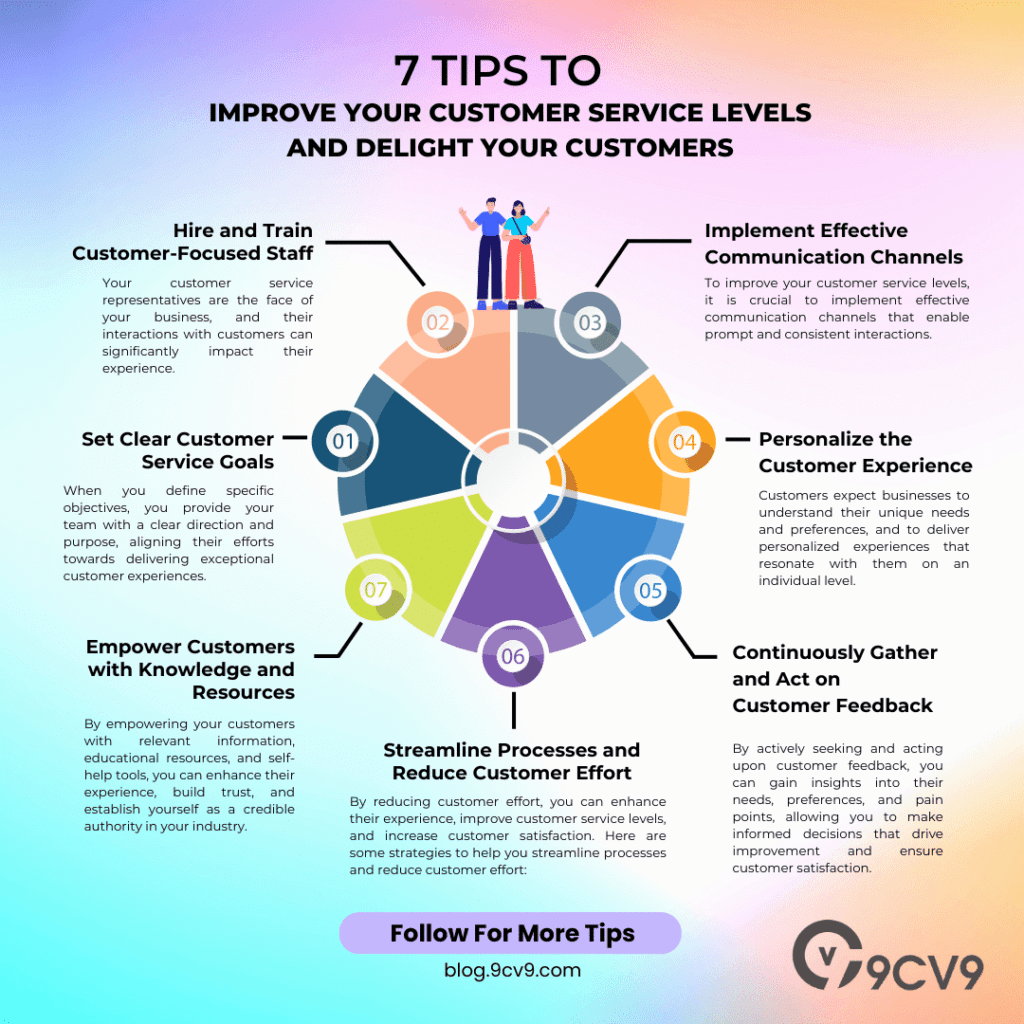
- Set Clear Customer Service Goals
- Hire and Train Customer-Focused Staff
- Implement Effective Communication Channels
- Personalize the Customer Experience
- Continuously Gather and Act on Customer Feedback
- Streamline Processes and Reduce Customer Effor
- Empower Customers with Knowledge and Resources
1. Set Clear Customer Service Goals
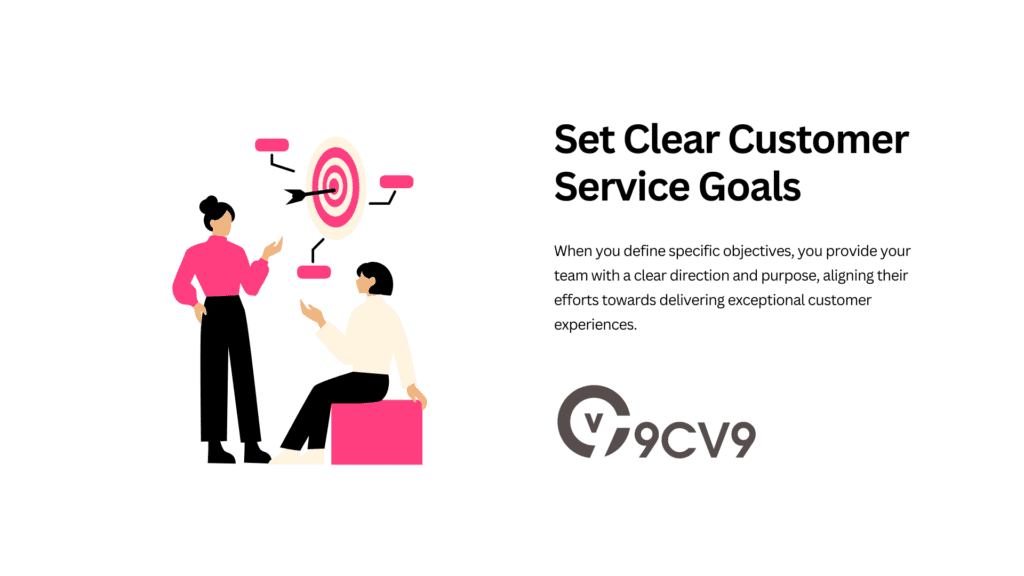
Setting clear and measurable goals is the foundation for improving your customer service levels.
When you define specific objectives, you provide your team with a clear direction and purpose, aligning their efforts towards delivering exceptional customer experiences.
Here are some key steps to help you set effective customer service goals:
- Understand Customer Expectations: Start by gaining a deep understanding of your customers’ expectations. Conduct market research, analyze customer feedback, and study industry benchmarks to identify the factors that matter most to your target audience. Are they looking for quick response times, personalized interactions, or knowledgeable support? By understanding their needs, you can tailor your goals to meet and exceed their expectations.
- Define Measurable Metrics: Ensure that your customer service goals are measurable, allowing you to track progress and evaluate performance objectively. Identify key performance indicators (KPIs) that align with your business objectives and customer expectations. Some common customer service metrics to consider include customer satisfaction scores (CSAT), Net Promoter Score (NPS), first-call resolution rate, average response time, and customer retention rate. These metrics will help you assess the effectiveness of your customer service efforts.
- Set Specific and Realistic Targets: Make your goals specific and realistic to provide clarity and attainability. For example, instead of aiming to “improve customer satisfaction,” set a specific target like “increase CSAT scores by 10% within the next quarter.” By establishing specific targets, you create a clear benchmark for success and motivate your team to strive for continuous improvement.
- Break Goals into Actionable Steps: Break down your customer service goals into actionable steps to make them more manageable. Identify the necessary processes, resources, and actions required to achieve each goal. Assign responsibilities and timelines to ensure accountability and progress tracking. This approach helps transform your goals from abstract ideas into practical initiatives that can be executed effectively.
- Foster Cross-Department Collaboration: Customer service goals are not limited to the customer support team alone. Successful implementation requires collaboration across departments to ensure a seamless customer experience throughout the customer journey. Involve stakeholders from sales, marketing, product development, and operations to gain diverse perspectives and align your goals with the overall business strategy. Collaboration fosters a customer-centric culture and promotes a unified approach towards achieving customer service excellence.
- Monitor and Adjust: Regularly monitor your progress towards the set goals and make adjustments as needed. Analyze customer feedback, review performance metrics, and identify areas of improvement. Celebrate milestones and successes along the way, while also addressing any challenges or roadblocks hindering your progress. Flexibility and adaptability are crucial to maintaining momentum and continuously refining your customer service efforts.
Remember, setting clear customer service goals is just the beginning.
To achieve success, you must communicate these goals effectively throughout the organization, provide the necessary resources and support, and regularly assess and recalibrate your strategies.
Clear goals empower your team, align their efforts, and serve as a compass for delivering outstanding customer service experiences.
In the next section, we will explore the importance of hiring and training customer-focused staff, discussing strategies to build a skilled and empathetic team that consistently exceeds customer expectations.
Also read, how to set goals as a high-performer in life here.
2. Hire and Train Customer-Focused Staff
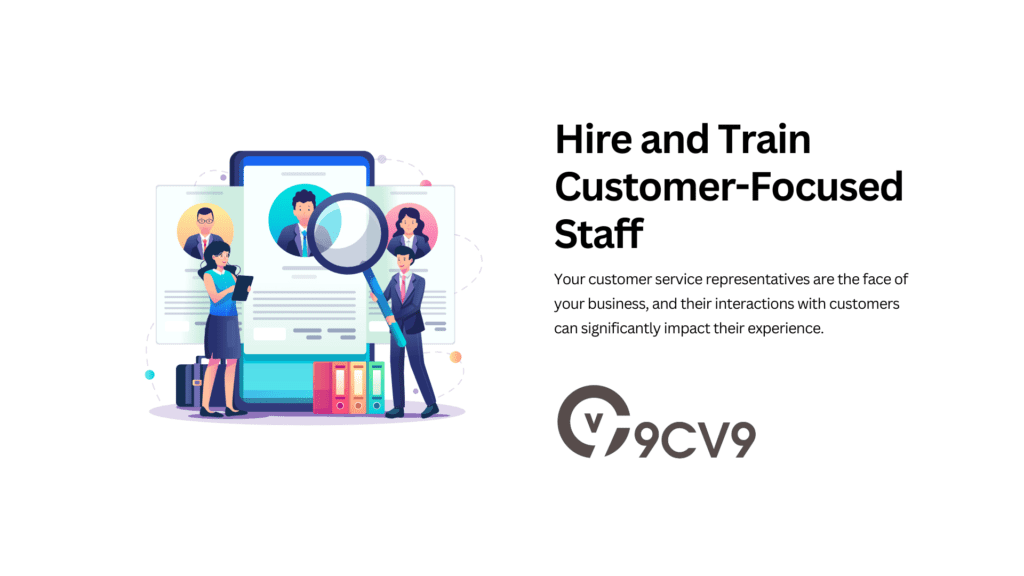
Building a team of customer-focused staff is essential for delivering exceptional customer service levels.
Your customer service representatives are the face of your business, and their interactions with customers can significantly impact their experience.
Here are some key strategies for hiring and training customer-focused staff:
- Define Customer-Focused Job Profiles: When hiring for customer service roles, develop clear job profiles that emphasize the importance of customer-centric skills and qualities. Outline the desired attributes, such as excellent communication skills, empathy, patience, problem-solving abilities, and a positive attitude. Tailor interview questions and assessments to evaluate candidates’ customer service aptitude and their ability to handle various customer scenarios. To learn how to write a top-class job description to get the best customer service staff, save and read our most popular guide: Mastering the Art of Writing Effective Job Descriptions: A Comprehensive Guide
- Conduct Behavioral-Based Interviews: In addition to traditional interviews, incorporate behavioral-based questions to assess candidates’ past experiences and how they have handled challenging customer situations. Ask candidates to share examples of how they resolved customer issues, exceeded expectations, or demonstrated empathy in previous roles. This approach helps identify individuals who have a track record of delivering exceptional customer service.
- Provide Comprehensive Training Programs: Once you have selected the right candidates, invest in comprehensive training programs to equip them with the skills and knowledge necessary to excel in their customer service roles. Training should cover various aspects, such as product knowledge, company policies and procedures, effective communication techniques, conflict resolution, and active listening skills. Offer both initial onboarding training and ongoing professional development opportunities to ensure continuous improvement. Also read, IT Upskilling Strategies: What are they and their importance in 2023.
- Foster a Customer-Centric Culture: Create a work environment that promotes a customer-centric culture. Encourage employees to prioritize the needs of customers and empower them to go above and beyond to deliver exceptional service. Recognize and reward employees who consistently demonstrate outstanding customer service, fostering a positive and supportive atmosphere that values customer satisfaction.
- Role-Play and Simulations: Incorporate role-playing exercises and simulations during training sessions to help employees practice handling various customer scenarios. By simulating real-life situations, you can provide valuable hands-on experience and equip employees with the necessary skills to handle different customer interactions effectively. Encourage feedback and provide constructive guidance to help employees improve their customer service techniques.
- Continual Feedback and Coaching: Implement regular feedback and coaching sessions to support employees’ development. Provide constructive feedback on their performance, highlighting areas of strength and areas that need improvement. Offer additional coaching and training resources to address specific skill gaps. Create a safe and supportive environment where employees feel comfortable seeking guidance and sharing their ideas for enhancing the customer experience.
- Lead by Example: Leadership plays a critical role in shaping a customer-focused team. Set the example by embodying the desired customer service qualities and behaviors. Demonstrate active listening, empathy, and problem-solving skills in your interactions with both employees and customers. Your actions will serve as a model for the team, reinforcing the importance of customer-centric values.
- Encourage Continuous Learning: Promote a culture of continuous learning and improvement within your customer service team. Encourage employees to stay updated on industry trends, best practices, and emerging technologies that can enhance the customer experience. Offer opportunities for professional development, such as workshops, webinars, and industry conferences, to expand employees’ knowledge and skills.
By hiring and training customer-focused staff, you lay the foundation for exceptional customer service levels.
Remember, it’s not just about technical skills but also about fostering a positive attitude, empathy, and effective communication.
A well-trained and motivated team will be better equipped to handle customer inquiries, resolve issues promptly, and exceed customer expectations.
In the next section, we will explore effective communication channels and strategies to ensure prompt and consistent customer interactions.
If your company needs HR, hiring, or corporate services to hire the best Customer Service Staff, you can use 9cv9 hiring and recruitment services. Book a consultation slot here, or send over an email to [email protected].
3. Implement Effective Communication Channels
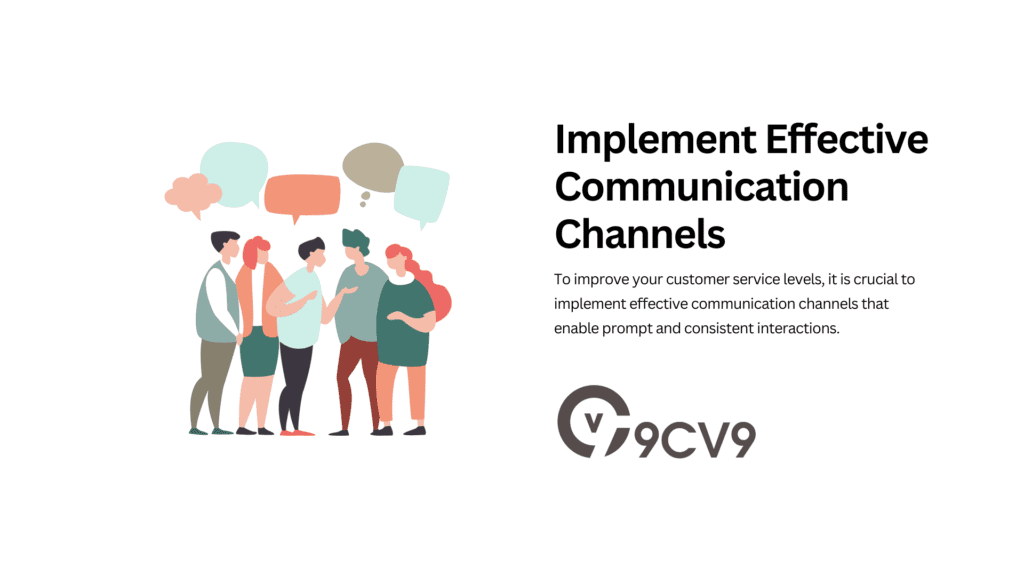
In today’s digital age, customers expect convenient and seamless communication options when interacting with businesses.
To improve your customer service levels, it is crucial to implement effective communication channels that enable prompt and consistent interactions.
Here are some strategies to consider:
- Phone Support: Phone support remains a vital communication channel for customers seeking immediate assistance or those who prefer a more personal interaction. Ensure that your phone support system is equipped with sufficient capacity to handle customer calls efficiently. Implement call routing and queuing systems to minimize wait times, and train your customer service representatives to handle calls professionally and effectively.
- Email Support: Email support offers a convenient and asynchronous way for customers to reach out with inquiries, issues, or feedback. Respond to customer emails promptly, ideally within 24 hours, to demonstrate your commitment to exceptional customer service. Use email management tools to track and organize customer inquiries, ensuring no message goes unanswered or gets lost in the shuffle.
- Live Chat: Live chat has gained popularity as a preferred communication channel for its real-time convenience. Implementing live chat software on your website allows customers to engage with your customer service representatives instantly. Ensure that your chat system is user-friendly and provides timely responses. Consider using chatbots or automated responses to handle common queries, providing immediate assistance even outside of regular business hours.
- Social Media: With the widespread use of social media platforms, customers increasingly turn to these channels to voice their opinions, seek support, or ask questions. Establish a strong presence on relevant social media platforms and actively monitor and respond to customer inquiries or concerns. Timely and professional engagement on social media can have a significant impact on your brand reputation and customer satisfaction.
- Self-Service Portals: Empower customers to find answers to their questions independently through self-service portals. Develop a comprehensive knowledge base or FAQ section on your website, addressing common queries and providing step-by-step tutorials. Include search functionality and categorize information logically to make it easily accessible. Additionally, offer troubleshooting guides, video tutorials, and product documentation to support self-help.
- Mobile Apps: If you have a mobile app for your business, integrate customer service features within the app. Offer in-app messaging or chat functionality to provide customers with convenient access to support while using your app. Enable push notifications to alert customers about important updates or responses to their inquiries. Mobile apps can streamline the communication process and enhance the overall customer experience.
- Omnichannel Integration: To deliver a seamless customer experience, integrate your communication channels to ensure continuity and consistency. Customers should be able to transition smoothly between different channels without having to repeat information or start the conversation from scratch. Implement a customer relationship management (CRM) system to centralize customer interactions and provide a holistic view of each customer’s communication history.
- Chatbots and AI-Powered Assistants: Leverage chatbot technology and AI-powered assistants to enhance your customer service capabilities. Chatbots can handle routine inquiries, provide instant responses, and guide customers through simple processes. AI-powered assistants can analyze customer data and provide personalized recommendations or proactive support. Implementing these technologies can improve response times, reduce customer wait times, and free up human agents to focus on more complex customer interactions.
When implementing communication channels, it is crucial to provide consistent and quality support across all touchpoints.
Respond promptly, address customer inquiries thoroughly, and personalize interactions whenever possible.
Strive for a seamless and integrated experience that demonstrates your commitment to delivering exceptional customer service.
In the next section, we will explore the importance of personalizing the customer experience to enhance satisfaction and build lasting relationships with your customers.
4. Personalize the Customer Experience
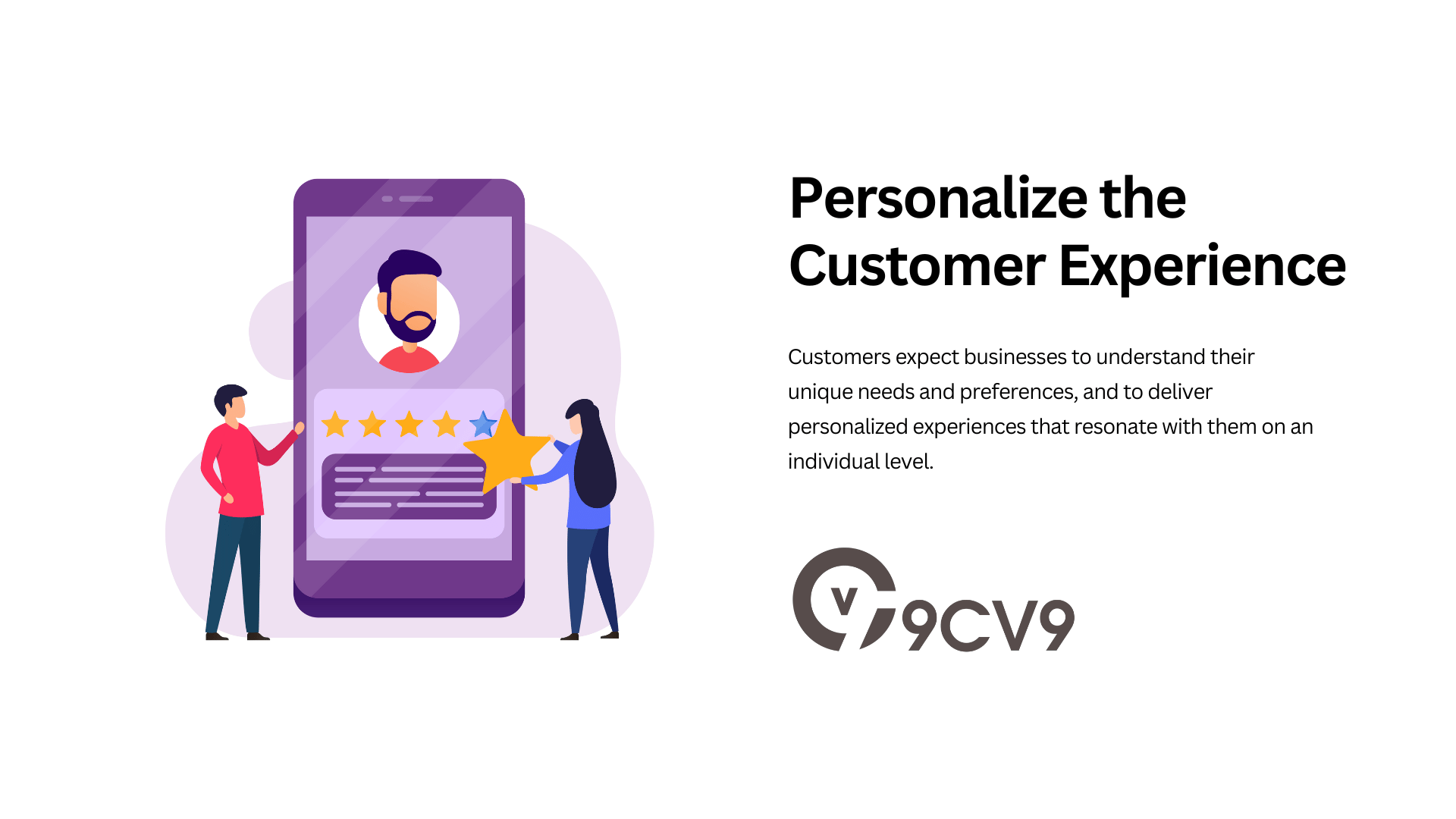
In today’s highly competitive business landscape, personalization has become a key driver of customer satisfaction and loyalty.
Customers expect businesses to understand their unique needs and preferences, and to deliver personalized experiences that resonate with them on an individual level.
By personalizing the customer experience, you can significantly improve your customer service levels.
Here are some strategies to consider:
- Collect and Analyze Customer Data: The first step towards personalization is gathering relevant customer data. Utilize customer relationship management (CRM) systems, analytics tools, and surveys to collect data on customer demographics, preferences, purchase history, and behavior. Analyze this data to gain valuable insights into your customers’ preferences and habits, allowing you to tailor your interactions accordingly.
- Segment Your Customer Base: Segmentation allows you to categorize your customers into distinct groups based on common characteristics or behaviors. By segmenting your customer base, you can develop targeted strategies and messaging that resonate with each group. For example, you might create segments based on demographics, purchase history, or engagement levels. This enables you to personalize your communication and offerings to suit the specific needs and interests of each segment.
- Implement Personalized Communication: Tailor your communication to each customer based on their preferences and past interactions. Use their names in emails or direct messages to create a sense of familiarity. Send targeted emails or newsletters that provide relevant content, recommendations, or exclusive offers based on their previous purchases or browsing history. Personalized communication shows that you value their individuality and increases the likelihood of engagement.
- Customize Product Recommendations: Leverage customer data and purchase history to provide personalized product recommendations. Use algorithms and machine learning to analyze patterns and suggest products or services that align with each customer’s preferences and buying habits. Display personalized recommendations on your website, in email campaigns, or during the checkout process. By offering tailored recommendations, you enhance the customer’s shopping experience and increase the chances of upselling or cross-selling.
- Personalize Customer Support Interactions: When customers reach out for support, personalize their experience by using their name and referencing previous interactions or purchases. Train your customer service representatives to review customer history before engaging with them. This enables them to provide more informed and personalized assistance, saving customers from repeating information and demonstrating your commitment to their satisfaction.
- Implement Loyalty Programs and Rewards: Create loyalty programs that reward customers for their continued engagement and purchases. Tailor these programs to provide personalized rewards based on each customer’s preferences and spending habits. Offer exclusive discounts, personalized offers, or early access to new products or services. Personalized loyalty programs make customers feel valued and appreciated, fostering long-term relationships and increasing customer loyalty.
- Provide Proactive Support: Anticipate customer needs and provide proactive support before they even reach out with an issue. Use data analysis and customer behavior tracking to identify potential pain points or upcoming needs. Reach out to customers with relevant information, tips, or solutions to help them have a seamless experience. Proactive support shows that you care about their success and enhances their perception of your brand.
- Seek Feedback and Act on It: Regularly seek customer feedback and use it to enhance personalization efforts. Ask for reviews, conduct surveys, or engage customers in focus groups to gather insights on their experiences and expectations. Analyze feedback to identify areas for improvement and incorporate customer suggestions into your personalization strategies. By listening to your customers and acting on their feedback, you demonstrate your commitment to their satisfaction and build stronger relationships.
Personalization is a powerful tool for creating meaningful connections with your customers.
By leveraging customer data, segmenting your customer base, and tailoring your communication and offerings, you can deliver personalized experiences that delight customers and foster long-term loyalty.
In the next section, we will explore the importance of continuously gathering and acting upon customer feedback to drive improvement and ensure customer satisfaction.
5. Continuously Gather and Act on Customer Feedback
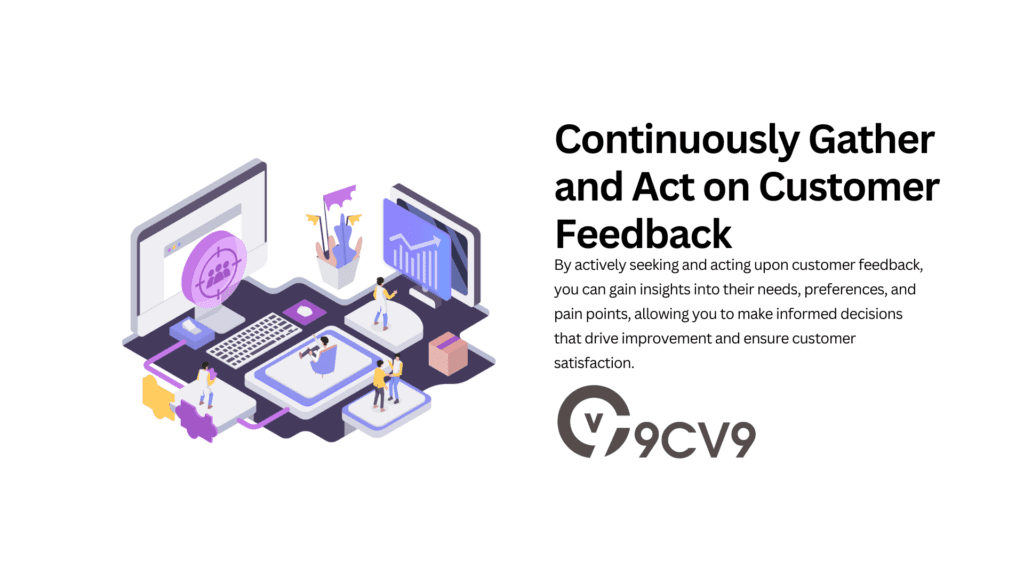
Customer feedback is an invaluable resource for improving your customer service levels and overall business performance.
By actively seeking and acting upon customer feedback, you can gain insights into their needs, preferences, and pain points, allowing you to make informed decisions that drive improvement and ensure customer satisfaction.
Here are some strategies to help you continuously gather and act on customer feedback:
- Implement Feedback Channels: Provide multiple channels for customers to share their feedback. This can include online surveys, feedback forms on your website, email surveys, social media polls, or even direct phone calls. Make it easy and convenient for customers to provide feedback by utilizing user-friendly interfaces and minimizing response barriers. Consider offering incentives, such as discounts or rewards, to encourage participation.
- Monitor Online Reviews and Social Media Mentions: Monitor online review platforms, social media channels, and industry-specific forums to stay informed about what customers are saying about your brand. Set up alerts or use reputation management tools to track mentions and reviews. Respond promptly to both positive and negative feedback, demonstrating your commitment to addressing customer concerns and acknowledging their positive experiences.
- Conduct Customer Surveys: Design well-structured surveys to gather specific feedback on different aspects of the customer experience. Use a mix of open-ended and closed-ended questions to capture both qualitative and quantitative data. Ask about satisfaction levels, overall experience, specific interactions, product or service quality, and suggestions for improvement. Keep surveys concise to maximize response rates and consider using skip logic to tailor questions based on customer responses.
- Engage in Social Listening: Social listening involves monitoring social media conversations and discussions related to your brand or industry. Use social media listening tools to track keywords, hashtags, and mentions relevant to your business. This allows you to gain real-time insights into customer sentiments, identify emerging trends, and address customer concerns proactively. Engage in conversations and provide helpful responses to build rapport and address customer needs.
- Leverage Customer Support Interactions: Your customer support interactions are a goldmine of feedback. Encourage your customer service representatives to actively listen to customer concerns, ask for feedback during interactions, and take notes on common issues or suggestions. Regularly review and analyze these insights to identify recurring themes and make necessary improvements to your products, services, or processes.
- Analyze Customer Behavior: Analyze customer behavior data to gain insights into their preferences, usage patterns, and engagement levels. Utilize web analytics tools, customer journey mapping, or heat mapping software to track customer interactions on your website or app. Identify areas where customers may be experiencing difficulties or drop-off points in the conversion process. Use this information to optimize your user experience and enhance customer satisfaction.
- Implement Net Promoter Score (NPS) Surveys: NPS surveys measure customer loyalty and satisfaction by asking customers how likely they are to recommend your brand to others. By calculating your NPS score, you can gauge overall customer sentiment and identify areas for improvement. Follow up with promoters and detractors to gather more specific feedback and address their concerns or suggestions.
- Actively Respond and Take Action: Customer feedback is only valuable if you act upon it. Respond promptly to customer feedback, whether it’s positive or negative. Thank customers for their input, address any issues or concerns, and outline the steps you are taking to resolve them. Share updates on the improvements you have implemented based on customer feedback. By demonstrating your commitment to acting upon customer input, you build trust and loyalty.
- Share Feedback Across the Organization: Ensure that customer feedback is shared across departments within your organization. Make it accessible to relevant teams, such as product development, marketing, and customer support. Encourage cross-functional collaboration to address customer needs holistically and drive improvement across all touchpoints. Regularly communicate customer feedback insights, trends, and action plans to create a customer-centric culture.
- Iterate and Continuously Improve: Gathering and acting on customer feedback should be an ongoing process. Regularly review feedback data, analyze trends, and identify areas for improvement. Develop a system for prioritizing and implementing changes based on customer input. Monitor the impact of these changes and gather further feedback to ensure they are driving the desired improvements.
By continuously gathering and acting upon customer feedback, you demonstrate your commitment to meeting their needs and expectations.
This iterative process of improvement not only enhances customer satisfaction but also helps you stay ahead of the competition and build long-term customer loyalty.
In the next section, we will explore the importance of measuring and tracking key customer service metrics to assess performance and identify areas for further improvement.
6. Streamline Processes and Reduce Customer Effort
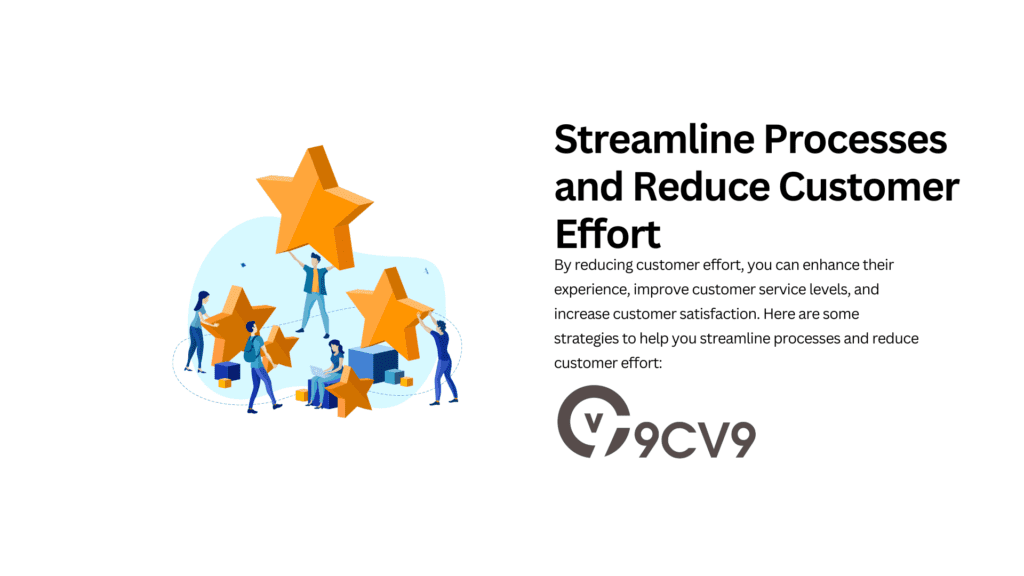
In today’s fast-paced business environment, customers value efficiency and convenience.
They expect businesses to streamline their processes and minimize the effort required to engage with their products or services.
By reducing customer effort, you can enhance their experience, improve customer service levels, and increase customer satisfaction. Here are some strategies to help you streamline processes and reduce customer effort:
- Map Customer Journeys: Start by mapping out your customer journeys to gain a deep understanding of the steps customers take when interacting with your business. Identify potential pain points, bottlenecks, or areas of friction that may cause frustration or increase customer effort. By visualizing the customer journey, you can pinpoint areas for improvement and implement streamlined processes.
- Optimize Website and App Navigation: Ensure that your website and mobile applications have intuitive navigation and user-friendly interfaces. Simplify menus, reduce clutter, and make it easy for customers to find the information or products they are looking for. Implement a search functionality that provides accurate and relevant results. Optimize page loading speed to minimize wait times, as slow-loading pages can significantly increase customer effort.
- Simplify Account Creation and Login Processes: Make it quick and straightforward for customers to create accounts and log in to their accounts. Minimize the number of required fields during registration and offer social login options to streamline the process. Allow customers to save their login credentials for future visits, eliminating the need to remember and re-enter passwords repeatedly. A smooth account creation and login process reduces customer effort and encourages engagement.
- Automate Routine Tasks: Identify repetitive tasks that customers frequently perform and automate them. For example, automate order confirmations, shipping notifications, and invoice generation. Implement self-service options for customers to update their account information, manage subscriptions, or track their orders. By automating these routine tasks, you free up customer time and effort, enabling them to focus on more important interactions.
- Provide Self-Service Options: Empower customers to find answers to their questions or resolve issues independently through self-service options. Develop a comprehensive knowledge base, FAQ section, or online tutorials that address common customer inquiries. Offer troubleshooting guides or step-by-step instructions for resolving common issues. Implement chatbots or virtual assistants to provide instant responses to frequently asked questions. Self-service options save customers time and effort, leading to a more positive experience.
- Simplify the Checkout Process: One area where customer effort can be significantly reduced is during the checkout process. Streamline your checkout flow by minimizing the number of steps and required fields. Offer guest checkout options to eliminate the need for customers to create an account. Provide clear progress indicators, auto-fill options, and convenient payment methods. Implement address verification tools to prevent errors and reduce friction during checkout.
- Integrate Systems and Improve Data Accessibility: Ensure that your internal systems are integrated and communicate seamlessly. This allows customer information to flow smoothly across different departments, eliminating the need for customers to repeat information or transfer calls. Improve data accessibility for your customer service representatives, enabling them to access relevant customer information quickly. This ensures a more efficient and personalized customer service experience.
- Offer Multi-Channel Support: Provide support across multiple channels, such as phone, email, live chat, and social media. Ensure that customer inquiries and issues can be seamlessly transferred between channels without customers needing to repeat information. Implement a centralized customer service platform that consolidates customer interactions from various channels. This enables a unified view of customer communication and reduces the effort required to resolve customer issues.
- Regularly Review and Improve Processes: Continuously evaluate and refine your processes to identify areas for further streamlining. Monitor customer feedback, analyze metrics, and seek input from your customer service team. Identify pain points or areas of high customer effort and develop action plans to address them. Regularly communicate process improvements to your customers, demonstrating your commitment to enhancing their experience.
By streamlining processes and reducing customer effort, you can create a frictionless experience that delights your customers.
This not only improves customer service levels but also increases customer loyalty and advocacy.
Remember, every small effort reduction contributes to an overall positive customer experience.
In the next section, we will explore the importance of leveraging technology to enhance customer service levels and drive efficiency.
7. Empower Customers with Knowledge and Resources
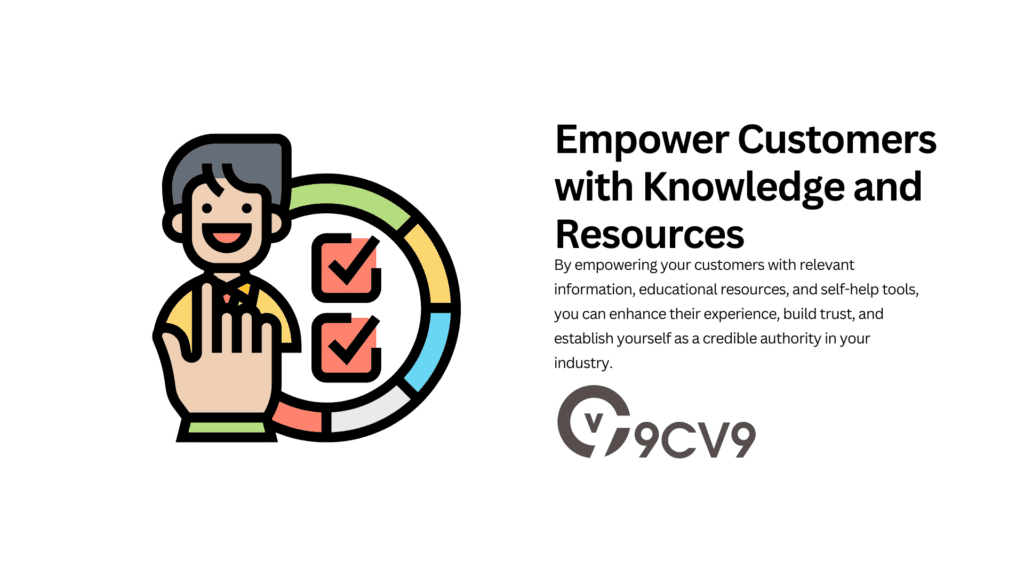
In today’s information-driven world, customers appreciate businesses that provide them with the knowledge and resources they need to make informed decisions and maximize the value they derive from products or services.
By empowering your customers with relevant information, educational resources, and self-help tools, you can enhance their experience, build trust, and establish yourself as a credible authority in your industry.
Here are some strategies to help you empower customers with knowledge and resources:
- Develop a Comprehensive Knowledge Base: Create a comprehensive knowledge base that serves as a centralized repository of information about your products, services, and common customer inquiries. Organize the knowledge base into categories and provide a search functionality to make it easy for customers to find the information they need. Include step-by-step guides, FAQs, troubleshooting tips, and best practices. Regularly update and expand the knowledge base based on customer feedback and emerging trends.
- Offer Educational Content: Create and share educational content that helps customers understand your industry, product features, and best practices. This can take the form of blog articles, whitepapers, e-books, videos, or webinars. Address common pain points, provide practical tips, and share insights that add value to your customers’ lives. By offering educational content, you position yourself as a trusted resource and empower customers to make informed decisions.
- Provide Onboarding and Training Resources: For complex products or services, offer onboarding and training resources to help customers get started and make the most of their purchase. Develop user guides, tutorials, video demos, or interactive training modules that walk customers through the setup, configuration, and usage of your offerings. Consider offering live training sessions or webinars where customers can interact with your team and ask questions. Effective onboarding and training resources empower customers to quickly become proficient users and increase their satisfaction.
- Implement a Community Forum: Create an online community forum where customers can connect with each other, ask questions, share experiences, and provide mutual support. Encourage active participation by your team members to address customer queries and provide expert advice. A community forum fosters engagement, encourages knowledge sharing, and allows customers to learn from each other. It also serves as a valuable source of insights and feedback for your business.
- Offer Personalized Recommendations: Utilize data and analytics to offer personalized product recommendations or content suggestions to customers. Analyze their purchase history, browsing behavior, and preferences to provide targeted recommendations that align with their interests and needs. This personalization enhances the customer experience, reduces decision-making effort, and increases the likelihood of cross-selling or upselling.
- Implement Self-Help Tools and Resources: Provide self-help tools and resources that empower customers to find solutions on their own. This can include interactive troubleshooting wizards, FAQ bots, interactive decision-making tools, or knowledge base search filters. These tools enable customers to troubleshoot issues, find answers, or explore options independently, reducing their reliance on customer support and enhancing their overall experience.
- Encourage User Reviews and Ratings: Encourage customers to leave reviews and ratings for your products or services. Display these reviews prominently on your website or product pages. Positive reviews build social proof and help potential customers make purchasing decisions with confidence. Respond to reviews, whether positive or negative, to show that you value customer feedback and are committed to addressing concerns.
- Foster Continuous Learning: Continuously update your knowledge base, educational resources, and training materials to keep pace with industry advancements and customer needs. Encourage feedback and suggestions from customers on areas where they would like more information or guidance. Regularly communicate updates and new resources to your customers to keep them informed and engaged.
By empowering customers with knowledge and resources, you create a supportive and informative environment that cultivates loyalty and customer satisfaction.
The more empowered and informed your customers are, the more likely they are to become advocates for your brand.
In the next section, we will explore the significance of measuring customer satisfaction and the role it plays in improving customer service levels.
Conclusion
Delivering exceptional customer service is a cornerstone of building a successful and sustainable business.
By implementing the strategies outlined in this article, you can significantly improve your customer service levels and create delightful experiences for your customers.
Let’s recap the seven key strategies we’ve discussed:
- Set Clear Customer Service Goals: Define measurable goals that align with your overall business objectives and prioritize customer satisfaction and loyalty.
- Hire and Train Customer-Focused Staff: Invest in recruiting and training customer-focused employees who possess excellent communication skills, empathy, and a genuine desire to help customers.
- Implement Effective Communication Channels: Offer a range of communication channels to ensure seamless interactions with customers and provide timely and personalized responses.
- Personalize the Customer Experience: Tailor your products, services, and interactions to meet the unique needs and preferences of individual customers, creating a personalized and memorable experience.
- Continuously Gather and Act on Customer Feedback: Regularly seek customer feedback through surveys, social listening, and customer support interactions. Use this feedback to drive improvements and make data-driven decisions.
- Streamline Processes and Reduce Customer Effort: Simplify and optimize processes to minimize customer effort, from website navigation to checkout procedures, enabling a frictionless and efficient experience.
- Empower Customers with Knowledge and Resources: Provide comprehensive knowledge bases, educational content, and self-help tools that empower customers to find information, make informed decisions, and resolve issues independently.
By implementing these strategies, you can elevate your customer service levels and create a customer-centric culture within your organization.
Remember, exceptional customer service is an ongoing journey.
Continuously monitor customer satisfaction metrics, adapt to evolving customer needs, and refine your approaches to stay ahead in a competitive market.
Not only do these strategies improve customer satisfaction and loyalty, but they also have a positive impact on your business’s bottom line.
Satisfied customers are more likely to become repeat customers, refer others to your business, and leave positive reviews, enhancing your brand reputation and attracting new customers.
In the dynamic and customer-centric landscape of today’s business world, prioritizing customer service excellence is essential for sustainable growth.
By consistently exceeding customer expectations, you can create a competitive advantage that sets your business apart from the rest.
So, take the initiative today to implement these seven strategies and start delighting your customers with exceptional service. Your efforts will pay off in the form of increased customer loyalty, positive word-of-mouth, and long-term business success.
Remember, happy customers are the heart of a thriving business.
If your company needs HR, hiring, or corporate services, you can use 9cv9 hiring and recruitment services. Book a consultation slot here, or send over an email to [email protected].
If you find this article useful, why not share it with your hiring manager and C-level suite friends and also leave a nice comment below?
We, at the 9cv9 Research Team, strive to bring the latest and most meaningful data, guides, and statistics to your doorstep.
To get access to top-quality guides, click over to 9cv9 Blog.
People Also Ask
What are the 3 levels of customer service?
The three levels of customer service are basic, expected, and exceptional. Basic customer service meets minimal requirements, expected customer service meets industry standards, and exceptional customer service goes above and beyond to create memorable experiences and exceed customer expectations.
What are service levels in customer service?
Service levels in customer service refer to the measurable benchmarks or standards that define the quality and efficiency of service delivery. They include factors like response time, resolution time, call abandonment rate, and customer satisfaction. Service levels help businesses set targets and ensure consistent and satisfactory customer experiences.
What are the 3 Ps of customer experience?
The three Ps of customer experience are People, Process, and Product. People refer to the employees and their interactions with customers. Process involves the systems and procedures in place to deliver a seamless experience. Product refers to the quality and relevance of the offerings. Focusing on these three Ps can help businesses create exceptional customer experiences.































![Writing A Good CV [6 Tips To Improve Your CV] 6 Tips To Improve Your CV](https://blog.9cv9.com/wp-content/uploads/2020/06/2020-06-02-2-100x70.png)


